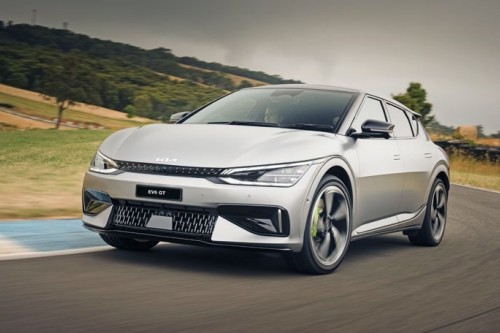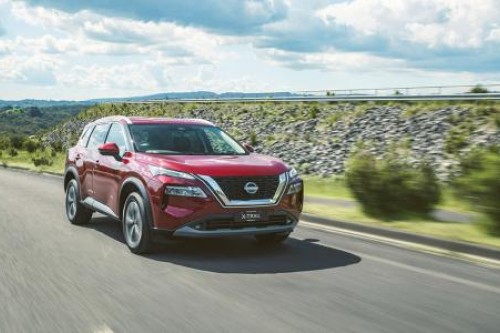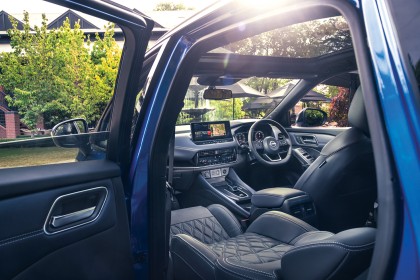
2024 NISSAN QASHQAI T1 E-POWER
A hybrid with a difference
Price: $51,590
Fuel Consumption: 5.2L/100km
ANCAP Safety Rating: Not Yet Rated
Warranty: Five-year warranty with unlimited kilometres
Hybrids are an each-way bet offering the best of an EV and an internal combustion engine (ICE) vehicle. Motorists driving hybrids get some of the efficiency benefits found in an EV, including energy recovery when decelerating, and also the convenient range of a petrol vehicle. With these vehicles increasing in popularity, the Nissan Qashqai e-POWER offers a slightly different version of hybrid technology.
Looks are worth a lot when it comes to cars, and the elegant exterior styling of the Qashqai combined with the classiness of its diamond- stitched interior detailing, mean this Nissan hybrid offers affordable luxury. The e-POWER hybrid is currently only available in the top spec Ti version, so new-car buyers will pay $4200 more than the ICE model. After on-road costs, the Qashqai e-POWER will set buyers back $55,780, which means it’s not the cheapest hybrid on the market.
That said, the e-POWER comes with modern luxuries such as front-seat massage functions, panoramic glass roof with electric sunshade, 10-speaker Bose sound system, 10.8-inch heads-up display, hands-free power tailgate and intelligent park assist. Nissan’s ProPILOT smart cruise system also provides lane-keep assist. The Qashqai pairs with a smartphone app that can send navigation and map data to the car and allows you to view the vehicle’s health status and even unlock/lock the doors remotely.
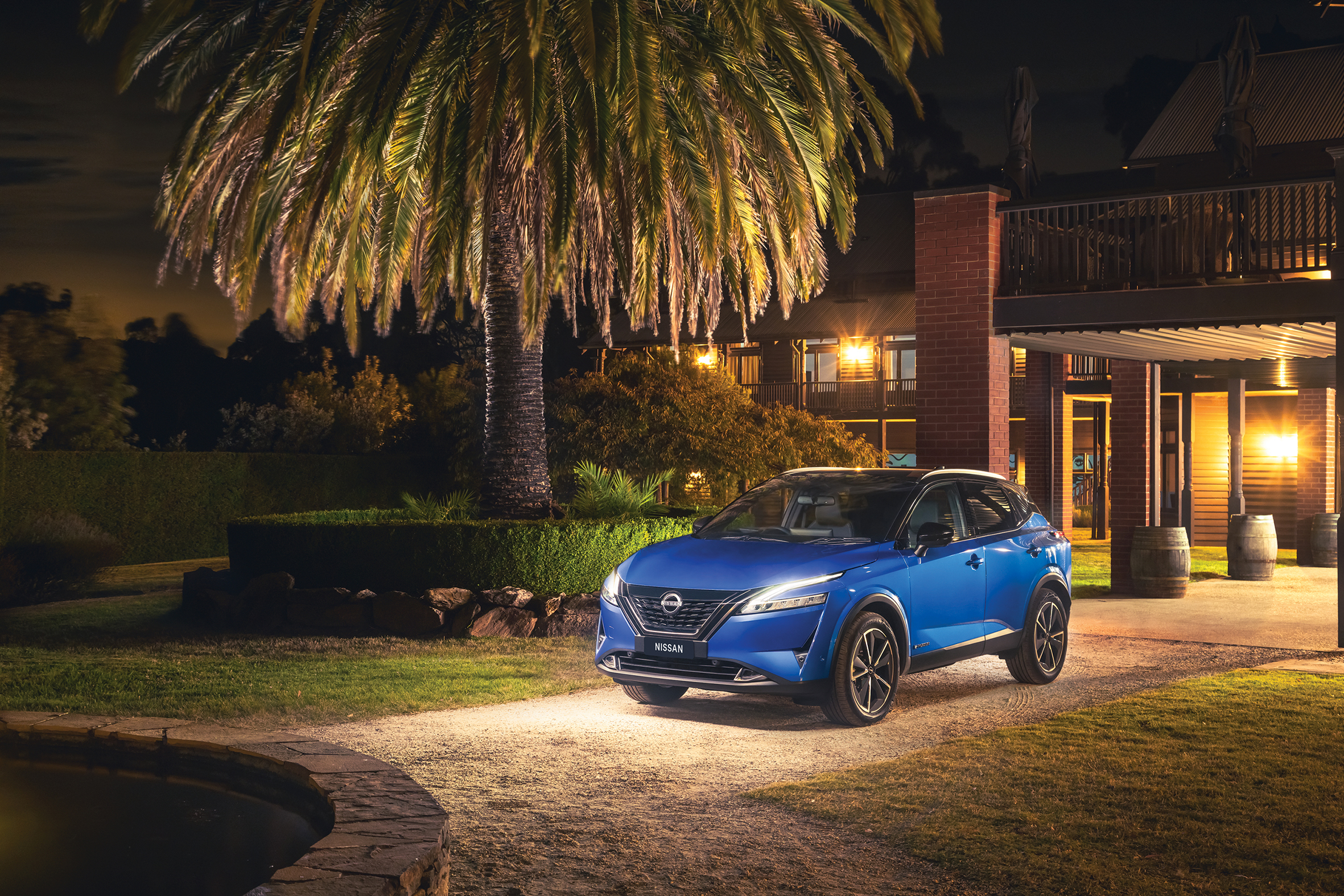
The Qashqai’s exceptional design elements include the space and comfort of the front seats, and the wide rear doors which provide easy access to the back seats. The information screen is easy to read and provides details about where the car’s electric energy is flowing.
Look in the Qashqai’s boot, and you’ll find a large cargo area, and Nissan’s Divide-N-Hide system that allows you to hide items under the floor. Design flaws include a lack of leg room for occupants in the rear seats and there isn’t a spare wheel, which has become commonplace for many new vehicles.
On the road, motorists will find Nissan’s e-POWER hybrid system isn’t like other traditional parallel hybrid systems. In the latter vehicle type, the electric motor or the internal combustion motor, or both at once, power the wheels. The e-POWER has a series hybrid system, using a 1.5-litre turbo-petrol engine to create electricity and charge the battery, which in turn sends power to an electric motor that drives the wheels.
Like most EVs, initial acceleration is exceptional and there isn’t irritating engine flaring that you may get with some other hybrids. The 2.1kW/h hybrid battery sits in the centre of the vehicle under the floor, and in EV-only mode has a maximum range of 3km. One-pedal driving is the benefit of an EV and can be activated with the push of a button on the console.
Overall, Nissan has taken a unique approach to hybrid technology, but the driving experience and packaging of the car makes it a great addition to the Qashqai range.
2024 HONDA CR-V VTI LX AWD
Honda's newest family-friendly option
Price: $57,000 (estimated driveaway)
Fuel Consumption: 7.7L/100km (91 RON)
ANCAP Safety Rating: Not Yet Rated
Warranty: Five-year warranty with unlimited kilometres
Honda’s CR-V was a pioneer of the modern-day mid-sized SUV, and after six generations it remains a family favourite. The original 1997 CR-V sold in droves and the latest model still has plenty to offer.
The all-new CR-V range starts at $44,500 and there are seven models, including a hybrid and some seven-seater options. For this review, we tested the upper spec VTi-LX with the all-wheel-drive option, which retails for about $57,000. Honda fixes that price – no haggling here – under its agency sales model. You’re buying the car directly from Honda (rather than a dealer) so the price doesn’t vary.
The CR-V uses the Honda Connect smartphone app, which is free for the first five years. After that, you’ll need to pay the
applicable subscription fees. The app allows you to perform some nifty tricks like remotely locking and unlocking the doors, geo-locating your car, turning the lights on and off and checking your fuel level, all without stepping into the cabin. If the app detects the airbag has deployed, it automatically notifies a call centre which sends emergency services to your location if required.

The all-new model is longer, wider and taller than its predecessors, which gives it a noticeably more spacious cabin and cargo area. It’s almost as roomy as a Mitsubishi Outlander or Nissan X-Trail, although both of those have cheaper entry-point options. Although not yet tested by ANCAP, it has a comprehensive list of active safety features including adaptive cruise control, lane-keeping assist, auto high beam, traffic sign recognition system, and cross-traffic and blind-spot monitoring.
A handy innovation is the wiper’s washing nozzle, which is built into the wiper arm. This provides a better spray straight onto the windscreen with less water use. The hands-free access power tailgate is another convenient feature, as are the 90-degree opening doors that make getting in and out easier, especially if you’re securing kids into their car seats. The thinner roof pillars also provide a better view from inside the car.
The CR-V has the same 1.5-litre turbo four- cylinder engine you’ll find in the Honda HR-V and Civic. Under normal driving conditions, the power is adequate and delivered quietly, but the continuously variable transmission (CVT) gets a bit noisier under hard acceleration. The all- wheel-drive version is essentially a CVT front- wheel drive, with the all-wheel-drive kicking in when it encounters wheel slippage. It’s mainly a vehicle for mud and snow but has hill descent and a full-size spare tyre – important features if you’re heading off road.
Honda has a reputation for high quality, and you get this in the new, family-friendly CR-V.
2024 NISSAN PATROL WARRIOR
The vehicle for serious off-roaders
Price: $104,160
Fuel Consumption: 14.4L/100km (95 RON)
ANCAP Safety Rating: Not Yet Rated
Warranty: Five-year warranty with unlimited kilometres
Nissan built its four-wheel-drive reputation in Australia on the back of the rugged Patrol. Although gas-guzzling
four-wheel drives aren’t everybody’s cup of tea, for those needing a hardcore off roader, the Patrol Warrior could be the car of choice.
To help customers make dedicated off-road modifications to their Patrols, Nissan has partnered with Victoria-based PremCar – one of Australia’s best vehicle engineering and modification companies. This helps make modifications legal and valid under Nissan’s factory warranties. The Warrior starts life as a Patrol Ti, which normally retails for about $84,900. After PremCar weaves its engineering magic, the price climbs to $104,160. This is still vastly cheaper than the Warrior’s nearest rival, the Toyota Landcruiser 300 GR Sport.
The Patrol is a decade-old platform and Nissan is trying to squeeze the last bit of value out of this model. The signature trim for the Warrior is a black Alcantara interior. The eight-seater is like most larger vehicles, with the two front rows comfortable for adults, but not so much for passengers in the backseat.
Nissan’s brief to PremCar was to expand the existing Patrol Ti’s capability without compromising comfort or convenience, and they’ve achieved that aim impressively. For example, PremCar has retained the full-size spare alloy wheel by redesigning the tow hitch and including two recovery points.
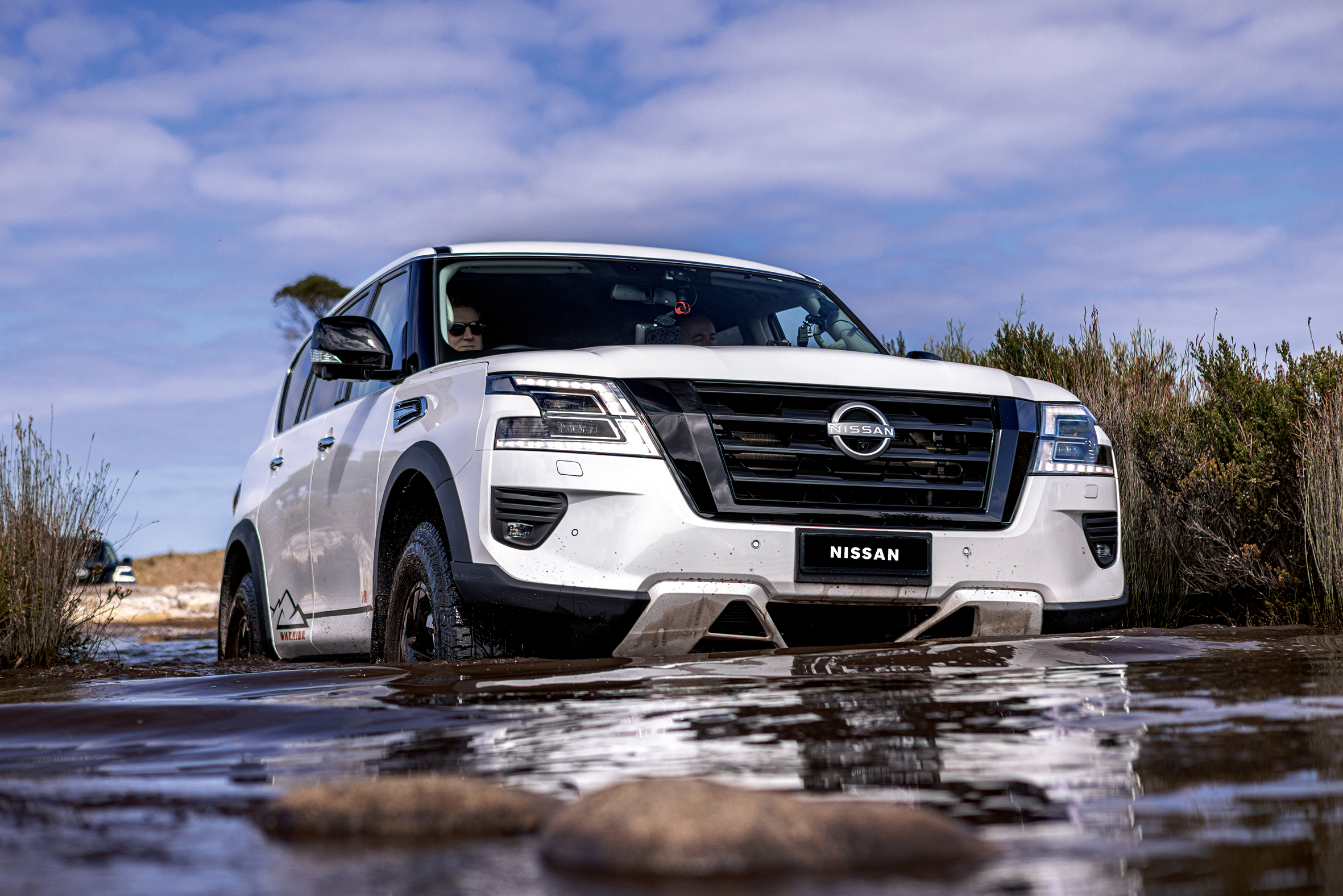
The Warrior is longer, wider and 50mm taller than the normal Ti model. But it doesn’t have roof rails, so PremCar could keep the roofline below two metres, allowing it to fit in undercover car parks. Despite this, the climb into the cabin is quite the gymnastic task, even with grab handles. On country bitumen roads, the ride from the dynamic suspension is still comfortable and predictable, considering the Warrior lacks anti-roll bars because they limit suspension travel. Instead, body roll is controlled hydraulically, which does everything that sway bars normally do.
Of note is the Warrior’s exhaust noise. With its bi-modal exhaust, it sounds like any Patrol Ti under normal driving conditions. However, under full throttle or above 3500rpm, the V8 side pipes come into play and emit a NASCAR-type exhaust note.
Get off the bitumen and onto severely rutted roads and the Warrior comes into its own. It has the wheel travel, suspension control and the four-wheel traction to cover seriously rugged terrain, making it one of the most capable four- wheel drives in Australia.
The flexibility of the 5.6-litre V8, from slow crawling the highway to overtaking, is excellent. The downside is that the Warrior is only available in the thirsty V8 model and needs the dearer 95 RON fuel; both factors are a slap to the wallet and environment.
The Warrior is for the select few who need leading-edge capability and towing capacity in a four-wheel drive. This Nissan isn’t cheap to buy or run and it’s not made for city driving but not many four-wheel drives on the market will outdo the Warrior.
2016 SUBARU LIBERTY 2.5I PREMIUM AWD
A safe,fun and reliable choice
Price When New: $35,900
Used Car Price Range: $15,300 - $19,600
ANCAP Safety Rating: 5 stars when new (current Used Car Safety Rating of 4 stars)
Subaru has established a solid reputation for vehicles that are safe, fun to drive and built to a high standard. The Japanese car manufacturer’s all-wheel-drive system gives its vehicles positive, sure-footed handling. These attributes are all
embodied in the 2016 Liberty – the mid- size sedan that seems to be ageing well.
Wrapped in a safety package that was ahead of the pack when new, the 2016 Liberty – now at half its brand-new price – is even better value on the used-car market. Subaru servicing costs are generally high, and the 100,000km service can be expensive. If you’re considering this model, try to find one that’s had the service completed, or you’ll get a nasty post-purchase bill. The 2.5-litre engine delivers good performance but is a bit thirsty on fuel, which will add to your ongoing costs.

Industry-leading safety technology is in Subaru’s DNA. Besides the standard autonomous emergency braking, the 2016 Liberty 2.5i Premium came with a vision assist system. This has blind-spot monitoring, lane- change assist, an auto-dimming rearview mirror, high-beam assist, and rear cross-traffic alert, which detects passing vehicles when reversing from parking spaces. It was quite the package in its day. The Liberty is spacious for a mid-sized vehicle and with folding rear seats, it’s particularly functional.
The infotainment system can be finicky to use, so try to make sure it works properly as these repairs can be expensive. The same goes for the navigation system.
The 2.5-litre flat four, boxer engine has ample power, delivered to all wheels via a CVT that gives six artificial gear shift points with selectable sports or intelligent modes. The Liberty is comfortable to drive in the city and if you take it on winding roads, it handles a little like a sports car. However, unlike a sports car, it has a good ride across most road types. This innate dynamic balance will help less experienced drivers cope with changing road conditions, especially out on regional roads.
Although SUVs are the used-car buyer’s sweethearts right now, a mid-size sedan like the Subaru Liberty is still a spacious and useful vehicle at an affordable price during these high cost-of-living times.
